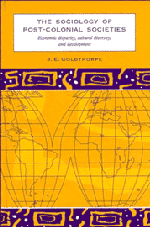Book contents
- Frontmatter
- Contents
- Preface and acknowledgements
- 1 Introduction and argument
- 2 Technology, society, and population
- 3 The colonial episode and the race question
- 4 Economic conditions
- 5 Environmental concerns
- 6 The social sciences and the ‘Third World’
- 7 The rise of towns
- 8 Family life in a changing world: two studies
- 9 Cultural diversity, language, education, and communications
- 10 Religion and development
- 11 Individual modernization: some psychological studies
- 12 Politics in post-colonial states
- 13 Aid and development
- Notes
- Index
9 - Cultural diversity, language, education, and communications
Published online by Cambridge University Press: 03 May 2011
- Frontmatter
- Contents
- Preface and acknowledgements
- 1 Introduction and argument
- 2 Technology, society, and population
- 3 The colonial episode and the race question
- 4 Economic conditions
- 5 Environmental concerns
- 6 The social sciences and the ‘Third World’
- 7 The rise of towns
- 8 Family life in a changing world: two studies
- 9 Cultural diversity, language, education, and communications
- 10 Religion and development
- 11 Individual modernization: some psychological studies
- 12 Politics in post-colonial states
- 13 Aid and development
- Notes
- Index
Summary
Cultural diversity
In the neolithic world of limited communications, human communities in relative isolation developed different cultures. The term culture in this context refers to a whole way of life: a complex whole including language, material culture or technology, social institutions, and religious, moral and aesthetic values. A culture is a combination of these elements in a total pattern recognizably different from other cultures, even those with which there are elements in common. Thus neighbouring societies might get their living in similar ways yet speak different languages and have different forms of political organization. There may be problems of delineation, as cultures shade over into one another; for instance, it may be a moot point whether two tongues are different languages or dialects of the same language. So we cannot say with precision how many different human cultures there are, or were, before the forces that in our time have made for the breaking down of isolation. But that should not lead us to minimize the extent and depth of cultural diversity, to which the whole science of social anthropology bears witness.
Cultural diversity, though a common characteristic of many ‘Third World’ countries, is not equally well marked in all. Some areas have long been exposed to the overlordship of a dominant people, whose culture has more or less heavily overlaid the indigenous folk-cultures, or even (as noted in chapter 3) extinguished them altogether.
- Type
- Chapter
- Information
- The Sociology of Post-Colonial SocietiesEconomic Disparity, Cultural Diversity and Development, pp. 149 - 178Publisher: Cambridge University PressPrint publication year: 1996



